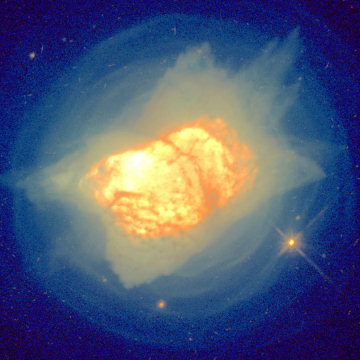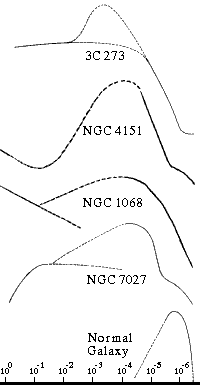Laser Emission from NGC 7027
 |
NGC 7027
Near infrared laser radiation from molecular hydrogen was detected in planetary nebula
NGC 7027.
The central star is the bright point in the center of the image.
Note the series of faint concentric shells far from the central star.
(Hubble Space Telescope Photo)
|
Tetsuo Hasegawa,
Institute of Astronomy, The University of Tokyo.
reprint of paper in 1989 conference Structure and Dynamics of the Interstellar Medium,
p.30, eds. Tenorio-Tagle,G., Moles,M., Melnick,J.,
Proceedings of the IAU Colloquium, No.120.
Lecture Notes in Physics, Springer Verlag, ISBN 0-387-51956-4
The nonthermal nature of the excitation of molecular hydrogen in
photodissociation regions becomes most prominent in the planetary nebula
NGC 7027. In 1989,
Hasegawa, et al. (1989)
discovered an extraordinarily strong emission of the H_2 (molecular hydrogen)
v=3-2, S(2) emission at 2.2864 microns in NGC 7027. This line was originally
found in the Fourier spectrum taken by
Treffers et al. (1976)
and remained unidentified since then.
The population distribution of H_2 analyzed by Hasegawa, Tanaka, and Brand
exhibits a highly nonthermal nature with v=3, J=4, 5, and 6 levels and
v=2, J=4 level significantly overpopulated. The v=3-2, S(2) transition is
inverted, and the contribution of induced emission, B I / c, is comparable
to that of spontaneous emission, A, where A and B are Einstein coefficients.
These are the characteristics of 'Laser' emission.
Detection of the unidentified line at 2.2864 microns in other sources are
found in the literature.
Isaacman (1984)
reports detection of this line in
two planetary nebulae IC 5117 and NGC 6572. In addition,
Thompson et al. (1978)
reports detection of this line in the nuclear region of the
Seyfert galaxy NGC 1068. Although measurements at higher spectral resolution
are required to assign these reported features observed at relatively low
resolution to the v=3-2, S(2) line of molecular hydrogen, these may suggest
that the laser emission of this line is a relatively common phenomenon.
COMMENT
Multi-wavelength studies reveal that the radio, microwave, infrared and optical
spectra of planetary nebula NGC 7027 is very different from a normal galaxy, but
very similar to quasar 3C 273, Seyfert NGC 4151 and NGC 1068 which
have jets emerging from their central star.
Also,
Thompson et al. (1978)
found the same infrared laser emission line in NGC 1068.
 |
Spectra of NGC 7027
Logarithmic energy distribution spectra of NGC 7027 and several other comparison
objects as a function of wavelength in meters.
Although quasars and similar objects called 'Seyfert galaxies' are assumed to be
extragalactic, their spectral similarities to planetary nebula NGC 7027 leads one to
question this assumption. The theory proposed by
Varshni (1979)
offers a simpler alternative, all these
objects are laser stars, a class of star related to the central stars
of planetary nebula
and high excitation
shell stars.
(plot from Weymann, 1969) |
Shell 'Galaxies'
Further similarities between these supposedly disparate classes of objects
are the faint concentric halos or shells discovered by David Malin using
darkroom amplification techniques
(Malin, 1978)
on photographs of 'shell galaxies'
(Malin and Carter, 1980).
There are over a hundred of these so-called shell 'galaxies'
(Malin and Carter, 1983)
In particular, the concentric shells or halos around NGC 3923
(Zepf et al., 1994)
resemble the faint shells of
NGC 7027
(see HST photo at top of page)
and the
'Egg' planetary nebula,
each object has at least five clearly visible concentric shells.
 |
NGC 3923
The visual appearance of the shells in NGC 3923 resembles those of NGC 7027.
Cosmologists are having a hard time coming up with models to explain these
concentric spherical shell, especially their sharp outer edges.
The currently popular theoretical 'patch' to explain these stunning results is the
galaxy collision merger model.
(Courtesy David Malin, copyright
Anglo-Australian Telescope Board) |
However a recent search for secondary nuclei in 'shell galaxies'
(Forbes et al., 1994)
has revealed very few candidates, any or all of which could be due chance
coincidence with foreground stars. Also
Schombert and Wallin (1987)
found shells which don't appear bluer that the core,
contradicting the primary assumption of the merger scenario.
The galaxy collision and merger model is becoming increasingly untenable,
exceedingly complex and obscure. Rather than admit that this recent
evidence is a strong indication that these objects could be within our galaxy ...
 ... the establishment defends itself by
complicating everything to the point of incomprehensibility.
... the establishment defends itself by
complicating everything to the point of incomprehensibility.
- Sir Fred Hoyle.
If these objects were within our galaxy,
the shells most probably (and simply) would originate from previous ejections and their
greater degree of symmetry indicates episodic outbursts of a more gentle
spherically symmetric wind or 'bubble' blown off during the past history of the star.
These features also show up in deep exposures of many other planetary nebulae
and mass losing stars (such as shell stars).
Since quasars are stars resembling the central stars of planetary nebula and shell stars,
these results were predicted by the laser star theory. We predict that
other properties common to the planetary nebula and shell stars will be
discovered in many of these so-called 'galaxies'.
References
- Hasegawa,T., Tanaka,M., and Brand,P.: 1989, ApJ. (Letters) Submitted
-
Tanaka,M., Hesegawa,T., Hayashi,S.S., Brand,P.W., Gatley,I.: 1989, ApJ., 336, 207.
-
Isaacman,R.: 1984, Astron.Aprophys., 130, 151.
-
Thompson,R., Lebofsky,M., Rieke,G.: 1978, Ap.J. (Letters), 222, L49.
-
Treffers,R., Fink,U., Larson,H., and Gauthier,T.: 1976, Ap.J., 209, 793.
- Weymann,R.J.: 1969, Sci.Amer., 'Seyfert Galaxies', January.
-
Geballe,T.R., Burton,M.G., Isaacman,R. : 1991, MNRAS, 253, 75.
-
Shell Galaxies with ATCA
-
Malin,D.F.: 1978, Nature, 276, 591.
-
Malin,D.F., Carter,D.: 1980, Nature, 285, 643.
-
Malin,D.F., Carter,D.: 1983, ApJ., 274, 534.
-
Carter et al. : 1988, MNRAS., 235, 813. Spectra of 'Shell Galaxy' Cores
-
Forbes, et al. : 1994, AJ, 107, 1713.
A search for secondary nuclei in shell galaxies (CCD Images)
-
Schombert,J.M., Wallin,J.F.: 1987, AJ, 94, 300.
ARP 227 - A case for shells without mergers? (CCD Images on plate 21 and page 2)
-
Zepf et al. : 1994, ApJ., 435, 117. NGC 3923 (shell galaxy)
(see also NOAO abstract)
Note Added in Proof:
Based on medium resolution spectra of NGC 7027,
Geballe et al. (1991)
argue that the 2.2864 micron line does not originate from H_2 because there is a lack of
correlation between it and other H_2 lines. We can show that this isn't a valid
counter argument because Varshni (1986) has demonstrated that laser gain depends
in a very sensitive way on the density and temperature. Consider the
following typical behavior of laser emission lines from a standard laser theory textbook :
As opposed to regular spontaneous emission, amplified spontaneous emission
increases exponentially as a function of distance travelled through the laser
gain medium. This exponential factor can lead to extremely large discrepancies
in the spatial variations between regular spontaneous emission and the laser
emissions. Therefore we conclude that there need not be spatial correlation
between the laser line and spontaneous emission lines. On the contrary,
we expect certain irregularities in the spatial distribution of laser emission
lines due to the slightly longer line-of-sight paths or stronger laser gains
in areas where the plasma deviates strongly from thermodynamic equilibrium.
Wether the strong line at 2.2864 microns turns out to originate from H_2 or not,
there need not be spatial correlation between the 2.2864 micron H_2 laser line
and other spontaneous emission lines from the same species.
Return to the What's New Page.




 ... the establishment defends itself by
complicating everything to the point of incomprehensibility.
... the establishment defends itself by
complicating everything to the point of incomprehensibility.